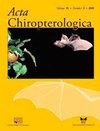Slight Increase in Bat Activity after Human Hibernation Count Monitoring of a Bunker Complex in Northern Germany
IF 0.7
4区 生物学
Q4 ZOOLOGY
引用次数: 2
Abstract
Winter counts in bat hibernacula are a standard method to monitor their populations. However, it is unclear to what degree counting bats in hibernacula triggers energy consuming arousals in hibernating bats. This study quantifies the reaction of three hibernating bat species (Pipistrellus sp., Myotis nattereri, and Plecotus auritus) to a monitoring survey in a hibernaculum complex consisting of eight modified bunkers in northern Germany. Skin temperatures of hibernating bats were measured with a thermal camera at the beginning and end of each visit to quantify the proportion of individuals that elevated their body temperatures during the visit. Moreover, bat activity was recorded using light barriers placed at the entrances of the hibernacula. According to the thermal camera measurements, eight of 1,849 individuals in Pipistrellus spp. (0.4%) and one of 47 individuals of M. nattereri (2.1%) elevated their body temperature during the monitoring. The median number of light barrier passes similarly increased slightly from seven to nine on monitoring days compared to control days. Notably, general linear models suggest that the effect of monitoring was less severe with rising ambient temperatures. Our results suggest that bat monitoring in hibernacula is unlikely to threaten winter survival in hibernating bats if carried out responsibly, and the number and duration of human visits are kept to a minimum.德国北部一个碉堡群的人类冬眠计数监测后蝙蝠活动略有增加
在蝙蝠冬眠地进行冬季计数是监测其种群数量的标准方法。然而,目前尚不清楚在冬眠中计数蝙蝠在多大程度上触发了冬眠蝙蝠的能量消耗唤醒。本研究量化了三种冬眠蝙蝠(Pipistrellus sp., Myotis nattereri和Plecotus auritus)对德国北部一个由八个改良掩体组成的冬眠地的监测调查的反应。在每次访问开始和结束时,用热像仪测量冬眠蝙蝠的皮肤温度,以量化访问期间体温升高的个体比例。此外,利用放置在冬眠洞口的光屏障记录了蝙蝠的活动。根据热像仪测量,1849只Pipistrellus spp. 8只(0.4%)和47只M. nattereri(2.1%)在监测期间体温升高。与对照日相比,监测日通过光障的中位数也从7次略微增加到9次。值得注意的是,一般线性模型表明,随着环境温度的升高,监测的影响不那么严重。我们的研究结果表明,如果进行负责任的监测,冬眠区的蝙蝠不太可能威胁冬眠蝙蝠的冬季生存,并且人类访问的次数和持续时间保持在最低限度。
本文章由计算机程序翻译,如有差异,请以英文原文为准。
求助全文
约1分钟内获得全文
求助全文
来源期刊

Acta Chiropterologica
生物-动物学
CiteScore
2.50
自引率
20.00%
发文量
42
审稿时长
>12 weeks
期刊介绍:
Acta Chiropterologica, published by the Museum and Institute of Zoology at the Polish Academy of Sciences, is devoted solely to the study and discussion of bats.
 求助内容:
求助内容: 应助结果提醒方式:
应助结果提醒方式:


